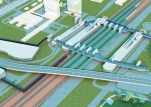Transportation Hub as an Urban Unit

In Moscow was adopted a large-scale building program of transportation hubs, most of which to be fundamental. Given the importance and complexity of this matter, it is necessary to consider the theoretical basis for its realization. The first part of the article on the methodological approach to the creation of transport hubs was published in the previous issue of the Green Buildings Magazine (2014, №3). In the second part we will focus on priority areas in terms of the development and the simulation model of a transport hub.
As a basis to identify the priority areas of development of transport hubs they use a system analysis, the structuring approach in particular. One of the main goals of the system analysis is to identify and to specify the composite elements of the purpose of the system, to determine the ways to achieve them. Regarding the development of a transport hub as a principal integrated program, we can dwell on the main objectives and tasks that are set while the system is reconstructed as an aims and tasks tree.
PRIORITIES
The main objective of a transport hub system is to improve the transportation conditions of the residents of a metropolitan area. On the one hand, this may be achieved by means of developing the passenger transport system; on the other hand, this may be realized by means of improving the transportation conditions of a street-and-road network.
The numerical ratings that define the improvement of the transportation conditions of the residents of a metropolitan area (in terms of the transport hub system) are:
– total number of passengers that pass through the transport hub per unit time (“rush” hour, day, year, etc.);
– number of passengers that make a connection in the transport hub;
– reduction of the total travel time at the expense of the connection time and the possibility of making a combined trip (when part of the trip is done with individual transport, and part of it is done with public transport);
– reduction of the individual traffic volume in the street-and-road network (SRN) at the critical points (for instance, at the entrance to the city or to its central urban zone (CUZ).
Full content of this issue you can read here
The full version of the article can be read in our printed issue, also you can subscribe to the web-version of the magazine
 Material provided by the Moscow General Planning Research and Project Institute, State Unitary Enterprise
Material provided by the Moscow General Planning Research and Project Institute, State Unitary Enterprise


